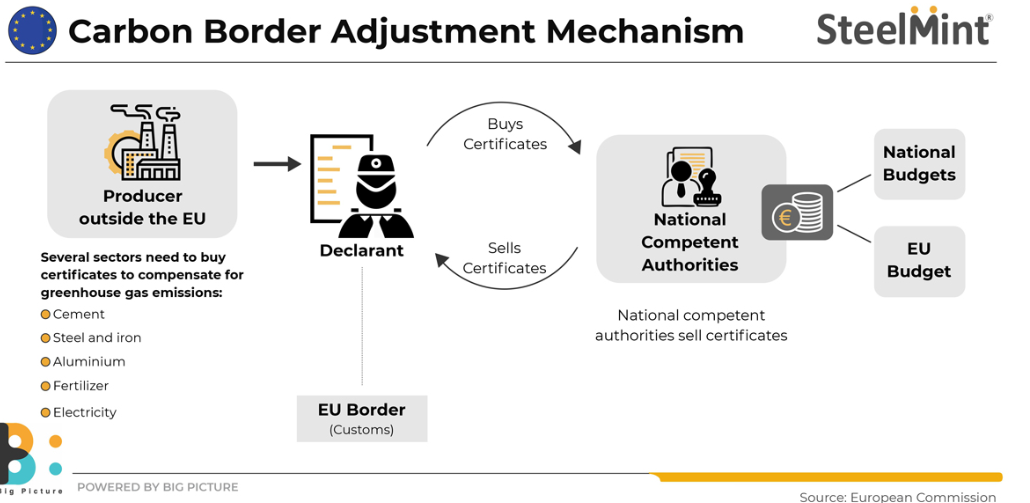16 November 2024 : Daily Current Affairs
1. India says climate finance is not an ‘investment goal’
- 1. India says climate finance is not an ‘investment goal’
- 2. No need for separate Central law to tackle crimes against health workers: NTF report
- 3. A jumbo crisis in Madhya Pradesh
- 4. Moody’s Retains India’s 7.2% Growth Projection for 2024 Amid Strong Fundamentals and Moderating Inflation
- Prelims Facts
- 1. President’s coalition sweeps Sri Lanka polls
- 2. Jeevan Pramaan Campaign Sees Rising Adoption of Digital Life Certificates
- 3. Empowering Tribal Society: Initiatives for Socio-Economic Development
(Source – The Hindu, International Edition – Page No. – 1, Page No. – 5 )
| Context |
|
India’s Position on Climate Finance
- India emphasised that climate finance should not be viewed as “investment goals” by developed countries.
- It highlighted that the Paris Agreement mandates developed countries to provide and mobilise climate finance unidirectionally to support developing nations.
- India reiterated that $5-6.8 trillion of climate finance is required globally until 2030, as per ongoing discussions.
- A New Collective Quantified Goal on Climate Finance is under deliberation, aiming to replace the outdated $100 billion annual target set in 2009 for 2020-2025.
Focus of COP29: New Climate Finance Target
- The COP29 discussions are critical for establishing a new operational target by 2025 to support developing nations’ transition to renewable energy without hindering developmental progress.
- India, representing developing nations, stressed that developed countries must commit to mobilising $1.3 trillion annually till 2030 to address climate adaptation and transition needs.
India’s Stance on Unilateral Trade Measures
- India strongly opposed “protectionist” trade measures linked to carbon emissions, stating that they are discriminatory and violate principles of equity.
- Such measures, India argued, shift the financial burden of low-carbon transitions onto developing and low-income countries.
China-Led Petition Against Trade Restrictions
- A petition led by a grouping of major developing countries proposed a formal agenda item to address unilateral trade measures linked to climate change.
- These measures primarily target the European Union’s Carbon Border Adjustment Mechanism (CBAM), a tax on imports not meeting EU carbon norms.
| What is Carbon Border Adjustment Mechanism (CBAM)? |
|
Purpose: The Carbon Border Adjustment Mechanism (CBAM) is a European Union proposal designed to impose a carbon tax on imported goods from countries with less stringent environmental regulations. Goal: It aims to prevent carbon leakage, ensuring that EU industries are not disadvantaged by stricter climate policies compared to foreign competitors. Products Affected: CBAM targets goods like cement, steel, aluminium, fertilisers, and electricity that are imported into the EU. Implementation: Currently in a transitional phase, CBAM will come into full effect on January 1, 2026. Controversy: The mechanism has faced criticism for being seen as a protectionist measure and discriminatory against developing nations, which might not have equivalent carbon policies. |
Key Concerns with CBAM
- India and other nations described CBAM-like policies as “arbitrary and unjustifiable unilateral measures”.
- These measures are seen as undermining multilateral cooperation on climate goals while disproportionately impacting developing countries.
| PYQ: Should the pursuit of carbon credit and the clean development mechanism set up under UNFCCC be maintained even though there has been a massive slide in the value of carbon credit? Discuss with respect to India’s energy needs for economic growth. (200 words/12.5m) (UPSC CSE (M) GS-3 2014) |
| Practice Question: Discuss the significance of equitable climate finance and the challenges posed by unilateral trade measures like the Carbon Border Adjustment Mechanism (CBAM) in fostering global cooperation for combating climate change. (250 Words /15 marks) |
2. No need for separate Central law to tackle crimes against health workers: NTF report
(Source – The Hindu, International Edition – Page No. – 3)
| Topic: GS2 – Governance |
| Context |
|
Opposition to a Separate Central Law
- The National Task Force (NTF), in its report filed in the Supreme Court concerning the R.G. Kar rape and murder case, stated that there is no need for a separate Central law to protect healthcare professionals.
- The NTF argued that State laws already have adequate provisions to address minor offences, while heinous offences can be addressed under the Bharatiya Nyaya Sanhita, 2023 (BNS).
- The report concluded that existing laws at the State level are sufficient for day-to-day offences, and a separate law was unnecessary.
State Laws and Enforcement Mechanisms
- 24 States have enacted laws protecting healthcare professionals, defining terms like “healthcare professional” and “medical professional.”
- The NTF report acknowledged that two more States have introduced Bills for the same.
- Where no specific State laws exist, the BNS can be used to address violence against healthcare professionals immediately.
Doctors’ Demand for a Central Law
- The NTF’s recommendation contradicted the demand from the Indian Medical Association (IMA), which advocated for a deterrent Central law and the designation of hospitals as safe zones.
- The IMA had highlighted the need for a national protocol to ensure the safety and security of medical professionals, especially following the tragic incident at R.G. Kar Medical College.
NTF Recommendations for Immediate and Long-Term Measures
- The NTF proposed short-term, medium-term, and long-term measures, including the deployment of trained security personnel, coordination with local police, and installing CCTVs.
- It emphasized that FIRs should be filed within six hours of reporting any violence against healthcare workers.
- The NTF identified poor communication between healthcare professionals and patients’ families as a major source of violence, leading to mistrust and mob attacks.
| Practice Question: Discuss the recommendations of the National Task Force (NTF) regarding the protection of healthcare professionals and the debate over a separate Central law. What measures can be taken to address violence against medical professionals in India? (250 Words /15 marks) |
3. A jumbo crisis in Madhya Pradesh
(Source – The Hindu, International Edition – Page No. – 7)
| Context |
|
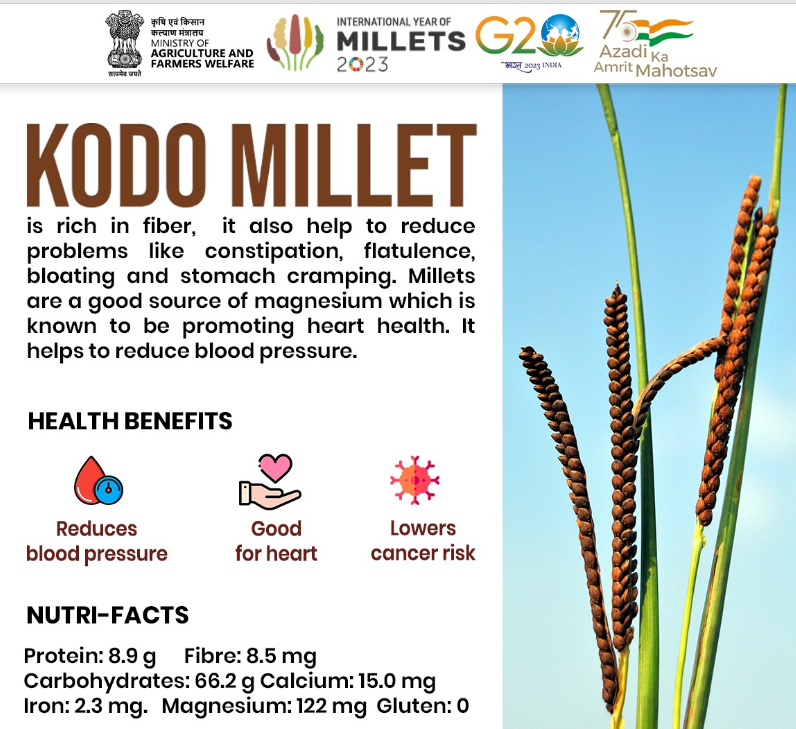
Cause of Death
- Toxicity from Kodo Millet:
- Post-mortem reports confirmed that the elephants died from consuming Kodo millet contaminated with cyclopiazonic acid, a toxin produced by a fungus found in Kodo crops.
- The Indian Veterinary Research Institute (IVRI) and ICRISAT confirmed high levels of the toxin in both the elephants’ organs and the Kodo crop from the affected farm.
- Symptoms of Toxicity: The elephants showed signs of distress, including difficulty moving, loss of balance, and lethargy before their deaths.
Official Reactions and Investigations
- Government Response:
- The State Government sent a high-level team to investigate the deaths, suspending key officials for negligence.
- The National Green Tribunal issued notices to various government agencies, including the Ministry of Agriculture and Wildlife Institute of India, regarding the deaths and Kodo millet’s role.
| Kodo Millet Cultivation: |
|
Agricultural Practices and Environmental Impact
- Fungal Infections:
- Environmental conditions in October, characterised by heavy rainfall and the ripening of Kodo millet, led to the growth of toxic fungi in the crops, which produced cyclopiazonic acid.
- Experts suggest that the toxicity might be common in Kodo millet during such climatic conditions but has received limited research attention, especially regarding its impact on elephants.
Bandhavgarh’s Elephant Management Challenges
- Increased Elephant Population:
- The elephant population in Madhya Pradesh has risen, with elephants from neighbouring states like Chhattisgarh and Odisha migrating into the region. Bandhavgarh alone hosts 65-70 elephants.
- Management Issues:
- The reserve faces challenges in tracking and managing this growing population.
- The lack of proper resources, such as tranquillisers, vehicles for protection, and trained personnel, hinders effective elephant management.
- Forest guards, such as Gyaan Singh, have faced threats from tigers and elephants without adequate safety measures.
- Lack of Infrastructure:
- The reserve lacks a dedicated veterinary facility for wildlife and relies on a single veterinarian.
- In the case of the elephant deaths, additional veterinary help was required but unavailable.
- The local community has expressed concerns over escalating human-animal conflict.
Future Actions and Proposals
- Elephant Monitoring:
- The forest department plans to use satellite collars on elephants to track their movements and prevent conflicts. There are also proposals to implement thermal imaging and trap cameras for better monitoring.
- Training and Infrastructure:
- Madhya Pradesh officials are being sent to Tamil Nadu and Karnataka to learn best practices in elephant management, including techniques for managing orphaned elephants and improving wildlife treatment facilities.
| Practice Question: Discuss the implications of the recent elephant deaths in Bandhavgarh Tiger Reserve due to Kodo millet contamination. Highlight the challenges of human-wildlife conflict, wildlife management, and the need for scientific research on wildlife nutrition. (150 Words /10 marks) |
4. Moody’s Retains India’s 7.2% Growth Projection for 2024 Amid Strong Fundamentals and Moderating Inflation
(Source: Indian Express; Section: Economy; Page: 16)
| Topic: GS3 – Indian Economy |
| Context: |
| The article discusses Moody’s 7.2% growth projection for India in 2024, highlighting factors like improving rural demand, infrastructure spending, and moderating inflation, despite concerns about urban demand and geopolitical risks. |
Analysis of News:
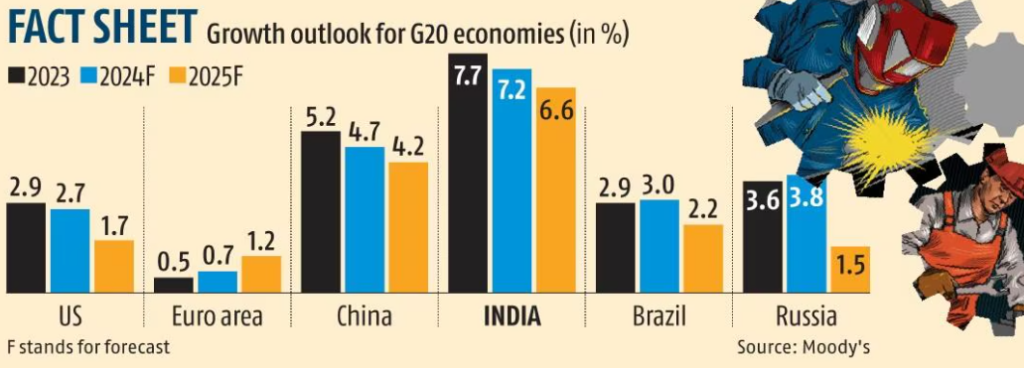
India’s Growth Outlook Remains Strong
- Despite concerns about urban demand moderation and high-frequency indicators signaling a slowdown, Moody’s has retained its 7.2% economic growth projection for India in 2024.
- Factors such as improving household consumption, robust rural demand, rising capacity utilization, and continued government infrastructure investments are expected to sustain this momentum.
- Growth is forecasted to moderate to 6.6% in 2025 and 6.5% in 2026.
Inflation and Policy Stance
- Inflationary pressures, driven by food prices, recently breached the RBI’s upper tolerance limit, reaching 6.2% in October.
- However, Moody’s expects inflation to moderate as food prices ease with higher sowing and ample buffer stocks.
- The RBI has maintained a cautious stance, keeping the repo rate steady at 6.5% and is likely to continue with tight monetary policies in the near term to balance inflation risks and growth dynamics.
Rural and Urban Demand Trends
- Rural demand is witnessing a steady uptick, supported by an improved agricultural outlook and rising incomes, while urban demand shows signs of softening due to weaker consumer sentiment.
- The festive season has provided a boost to household consumption, further aiding economic activity.
Drivers of Economic Growth
- Key growth drivers include expanding manufacturing and services sectors, robust credit growth, and strong consumer optimism.
- Government-led infrastructure spending, rising capacity utilization, and improving business sentiment are expected to bolster private investment.
- Healthy corporate and bank balance sheets, coupled with a stronger external position and ample forex reserves, underpin the resilient growth outlook.
Risks to Growth and Inflation
- Potential risks to growth include heightened geopolitical tensions and extreme weather events, which could disrupt supply chains and exacerbate inflation.
- While food price volatility continues to challenge the disinflation trajectory, the government’s proactive measures to ensure food grain availability are expected to mitigate these risks.
Conclusion
- India’s economy remains on a robust trajectory, with solid growth and moderating inflation creating a favorable macroeconomic environment. Moody’s outlook highlights the interplay of strong fundamentals and policy measures in sustaining growth amid external and internal challenges.
| Practice Question: Evaluate the factors contributing to India’s projected 7.2% economic growth in 2024, considering the challenges of urban demand moderation, inflationary pressures, and global risks. How can the government and RBI balance growth and inflation in the coming years? (250 words/15 m) |
Prelims Facts
1. President’s coalition sweeps Sri Lanka polls
(Source – The Hindu, International Edition – Page No. – 1)
| Context |
|
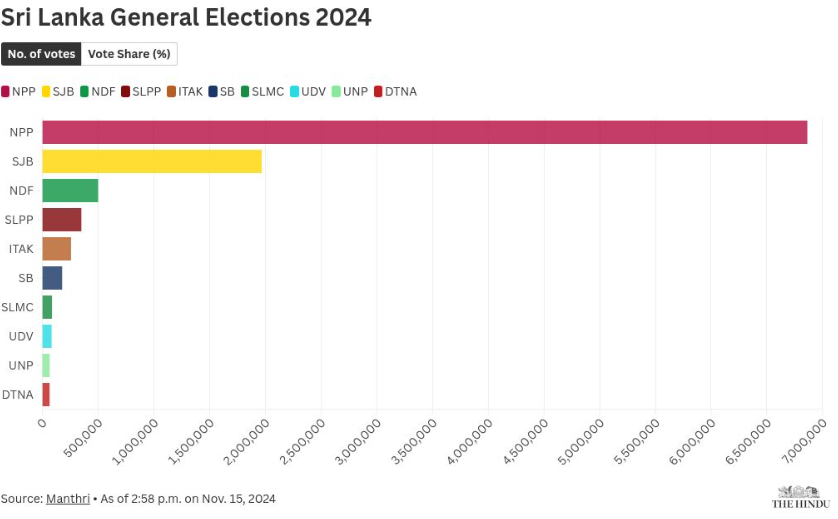
Analysis of the news:
- President Anura Kumara Dissanayake’s National People’s Power (NPP) alliance secured a historic landslide win in Sri Lanka’s November 14 general elections.
- The NPP won 159 seats in the 225-member Parliament, achieving over a two-thirds majority, while the Opposition Samagi Jana Balawegaya (SJB) won just 40 seats.
- The Rajapaksas’ Sri Lanka Podujana Peramuna suffered a massive defeat, reducing their presence to just three seats from 145 in 2020.
- The NPP’s remarkable mandate in Tamil and Muslim-dominated regions like Jaffna and the hill country signalled a shift in voting patterns.
- This marks the first two-thirds majority under Sri Lanka’s proportional representation system, paving the way for political and economic reforms.
| Political System of Sri Lanka |
|
Type of Government: Sri Lanka is a unitary democratic republic under a semi-presidential system. Constitution: Operates under the Constitution of 1978, establishing a strong executive presidency. Executive Branch: The President is both the Head of State, Head of Government, and Commander-in-Chief of the Armed Forces. The Prime Minister is the senior minister and assists the President. Legislature: The Parliament is a unicameral body with 225 members, elected for a 5-year term.It is responsible for making laws, approving budgets, and overseeing the executive. Judiciary: An independent system with the Supreme Court as the highest authority. Decentralisation: Governed through provinces with limited autonomy under provincial councils. Elections: Conducted under proportional representation. Political Parties: Multi-party system with dominant parties like NPP and SJB. |
2. Jeevan Pramaan Campaign Sees Rising Adoption of Digital Life Certificates
(Source: Indian Express; Section: Explained; Page: 15)
| Context: |
| The article highlights the annual Digital Life Certificate (DLC) campaign, which simplifies pension verification through online and biometric authentication, enhancing convenience for pensioners. |
Analysis of News:
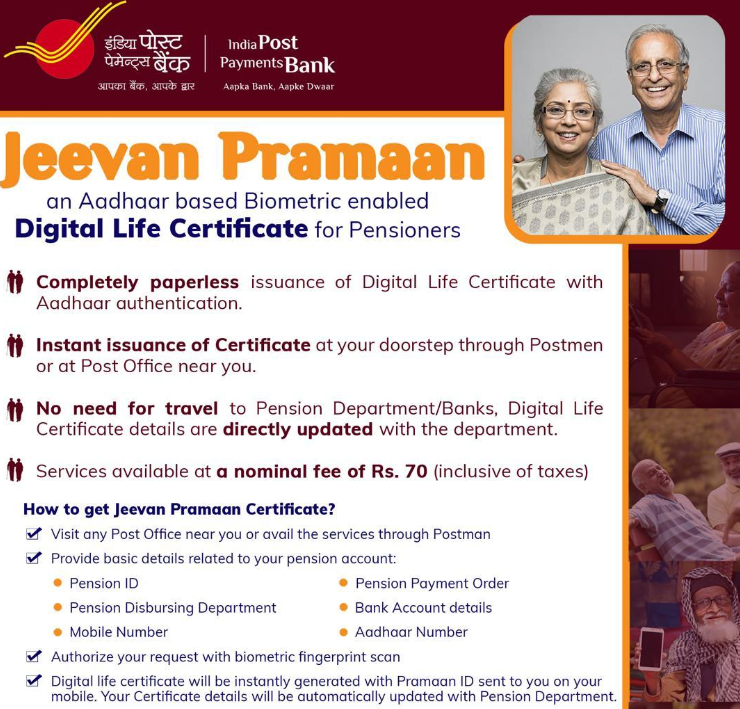
About Digital Life Certificate (Jeevan Pramaan)
- The Digital Life Certificate for Pensioners Scheme of the Government, known as Jeevan Pramaan, is a biometric-enabled digital service for pensioners.
- It was introduced in 2014 to simplify and enhance the convenience of life certificate submissions for pensioners.
Purpose:
- One of the major requisites for pensioners after their retirement from the service is to provide life certificates to authorized pension disbursing agencies like the bank, following which their pension is credited to their account.
- In order to get this life certificate, the individual drawing the pension is required to be either personally present themselves before the Pension Disbursing Agency or to have the Life Certificate issued by authority where they have served earlier and have it delivered to the disbursing agency.
- The Jeevan Pramaan scheme seeks to address this very problem by digitizing the whole process of securing the life certificate.
- Pensioners have the option to create Jeevan Pramaan, either online or via a mobile app.
- Using Jeevan Pramaan, a pensioner can now digitally provide proof of his/her existence to authorities for continuity of pension every year instead of requiring to appear in person before the certifying authority or the disbursing agency.
- It employs biometric authentication to validate the pensioner’s identity, effectively preventing fraudulent activity.
Beneficiaries:
- Pensioners of the Central Government, State Government, or any other Government organization can take benefit of this facility.
- It is not available to remarried or reemployed Pensioners. They are required to submit the life certificate the conventional way to their pension disbursing authority.
Pensioner Statistics and DLC Performance
Pensioner Data:
- India has 64.88 lakh central government pensioners as of March 31, 2023.
- Includes Defence, Railways, telecom, and postal pensioners.
DLC Uptake in 2023:
- 48.10 lakh DLCs generated between November 1-11.
- Fingerprint authentication preferred by 63% of pensioners, while face authentication use rose to 31%.
- Most submissions from pensioners aged 60-70 years.
Regional and Demographic Trends
State Participation:
- Maharashtra leads in DLC generation, followed by Tamil Nadu, West Bengal, Uttar Pradesh, and Karnataka.
Age Distribution:
- Majority of DLCs generated for pensioners aged 60-70 (45%), followed by 70-80 (28%), and below 60 (21%).
3. Empowering Tribal Society: Initiatives for Socio-Economic Development
(Source – https://pib.gov.in/PressReleseDetail.aspx?PRID=2073549®=3&lang=1 )
| Context |
|
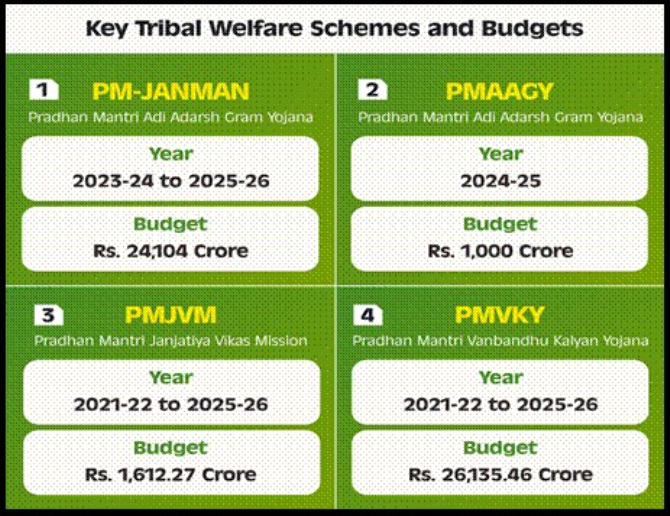
1. Dharti Aaba Janjatiya Gram Utkarsh Abhiyan
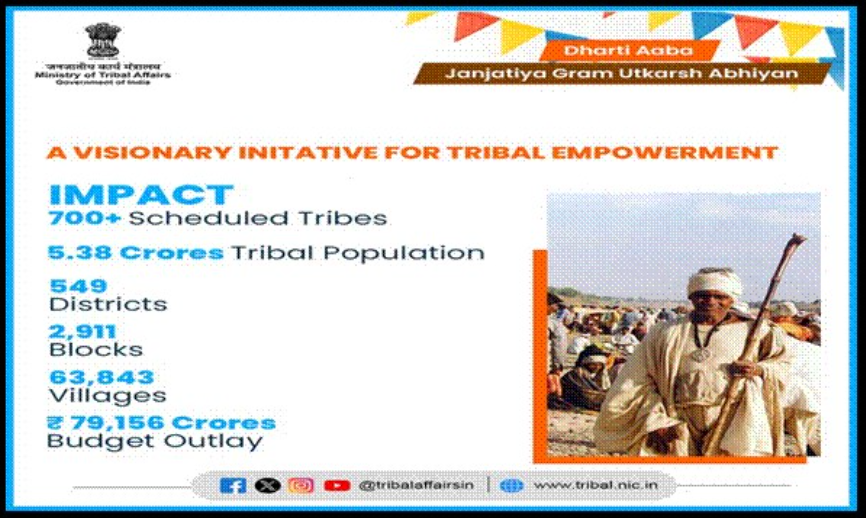
- Launched: October 2, 2024, by Prime Minister in Hazaribag, Jharkhand.
- Objective: To address critical gaps in infrastructure, health, education, and livelihood development across 63,843 tribal villages.
- Outlay: ₹79,156 crore allocated for the initiative.
- Key Focus: Social infrastructure improvements, healthcare, quality education, and enhancing livelihoods.
- Significance: Aims to transform rural and remote tribal areas, fostering overall socio-economic growth.
2. Pradhan Mantri Janjati Adivasi Nyaya Maha Abhiyan (PM-JANMAN)

- Launched: November 15, 2023, during Janjatiya Gaurav Divas in Khunti, Jharkhand.
- Objective: Upliftment of Particularly Vulnerable Tribal Groups (PVTGs).
- Focus Areas: Safe housing, clean drinking water, education, health, electrification, road connectivity, and sustainable livelihoods.
- Implementation: Aimed at transforming underdeveloped tribal regions with targeted interventions for their specific needs.
- Significance: Strengthening tribal communities’ access to basic rights and amenities.
3. Pradhan Mantri Adi Adarsh Gram Yojana (PMAAGY)
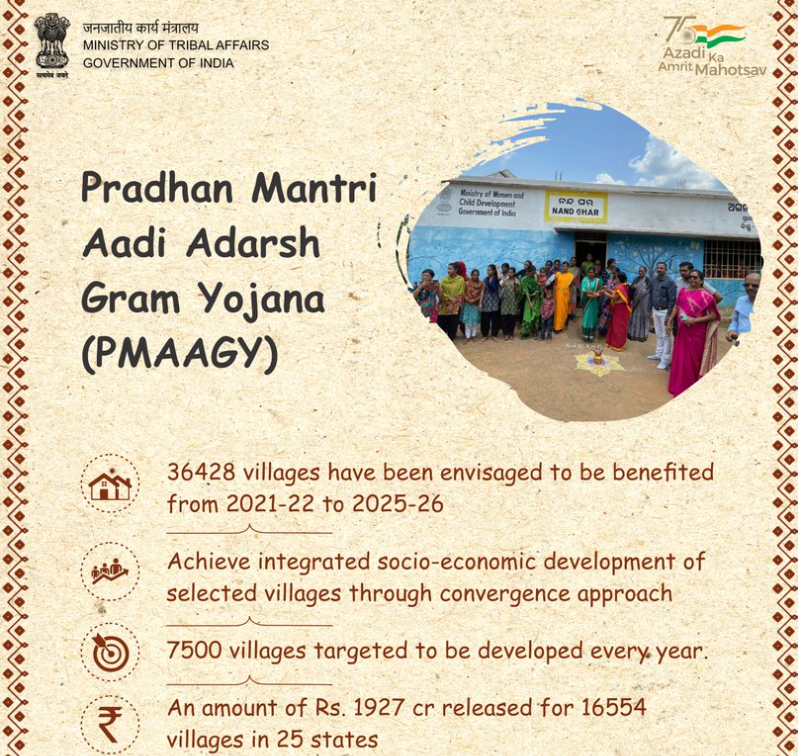
- Revamped: 2021-22, initially launched as the Special Central Assistance to Tribal Sub-Scheme (SCA to TSS) in 1977-78.
- Objective: Focus on providing basic infrastructure and facilities to villages with significant tribal populations.
- Target: Development of 36,428 villages with over 50% tribal population, especially in Aspirational Districts.
- Key Areas: Infrastructure development in education, health, water, and sanitation.
- Goal: To ensure a holistic upliftment of tribal villages by improving their socio-economic status.
4. Eklavya Model Residential Schools (EMRS)
- Launched: 2018-19 to provide quality education to tribal students.
- Objective: Offer a model of academic excellence, cultural integration, and skill development for tribal children.
- Key Features: Focus on developing students’ academic potential and cultural identity.
- Impact: In 2024, 40 new EMRS were inaugurated, and 25 more are being developed, with an investment of over ₹2,800 crore.
- Expansion: 728 EMRSs approved across India to date.
5. Pradhan Mantri Janjatiya Vikas Mission (PMJVM)
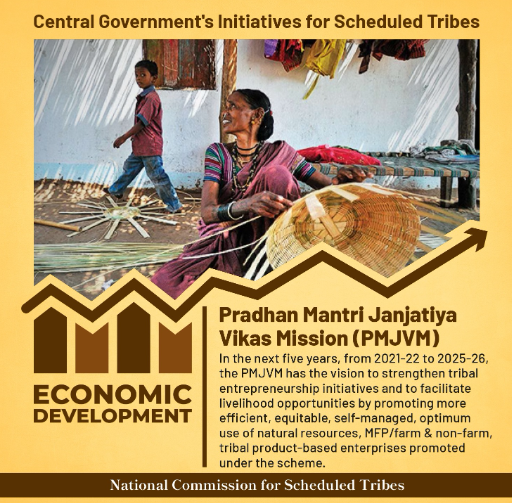
- Objective: Boost tribal entrepreneurship and support the “Vocal for Local by Tribal” initiative.
- Focus Areas: Promotes sustainable livelihoods through the better use of natural resources, including Minor Forest Products (MFPs).
- Economic Impact: Encourages economic self-sufficiency and entrepreneurship among tribal communities.
- Significance: Helps empower tribal communities through economic development and self-reliance.
6. Pradhan Mantri Vanbandhu Kalyan Yojana (PMVKY)
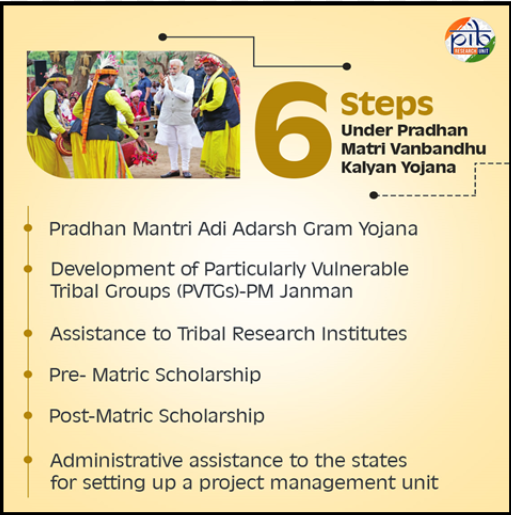
- Launched: October 28, 2014.
- Objective: To empower tribal communities and address their unique socio-economic challenges.
- Key Features: Focus on health, education, infrastructure, and socio-economic upliftment.
- Areas of Focus: Includes tribal areas’ development in infrastructure, employment, education, and health.
- Goal: Improve the living standards of tribal populations, preserving their cultural heritage.
7. Pre-Matric and Post-Matric Scholarship Schemes
- Pre-Matric Scholarship: Provides financial assistance for ST students in Classes IX and X to encourage their continuation of education.
- Post-Matric Scholarship: Extends financial support for higher education (Class XI to postgraduate courses).
- Impact: Reduces dropout rates among tribal students and supports their academic progression.
- Significance: Ensures equitable access to education for tribal students and fosters socio-economic development.
8. National Overseas Scholarship for ST Students
- Objective: Offers financial support for meritorious ST students to pursue postgraduate, doctoral, and post-doctoral studies abroad.
- Impact: Enhances the educational prospects of tribal students at global institutions.
- Eligibility: For students who have secured admission to renowned international universities.
- Significance: Promotes global education and exposure, enriching tribal communities’ knowledge base.
9. National Fellowship for ST Students
- Objective: Provides financial support for tribal students pursuing higher education in India.
- Process: Fully digital process for fellowship distribution, with integration through DigiLocker for timely assistance.
- Impact: Improves access to higher education for tribal students and ensures their academic success.
10. National Scheduled Tribes Finance and Development Corporation (NSTFDC)
- Objective: Provides concessional loans for self-employment and income-generating activities.
- Key Schemes:
- Term Loan Scheme: Loans up to ₹50 lakh for income-generating projects.
- Adivasi Mahila Sashaktikaran Yojana: Loans up to ₹2 lakh for tribal women.
- Micro Credit Scheme for Self-Help Groups: Loans up to ₹5 lakh per group.
- Impact: Aims to promote economic development and self-sufficiency among tribal communities.
- Significance: Supports income generation and financial independence for Scheduled Tribes.
11. Sickle Cell Anaemia Elimination Mission
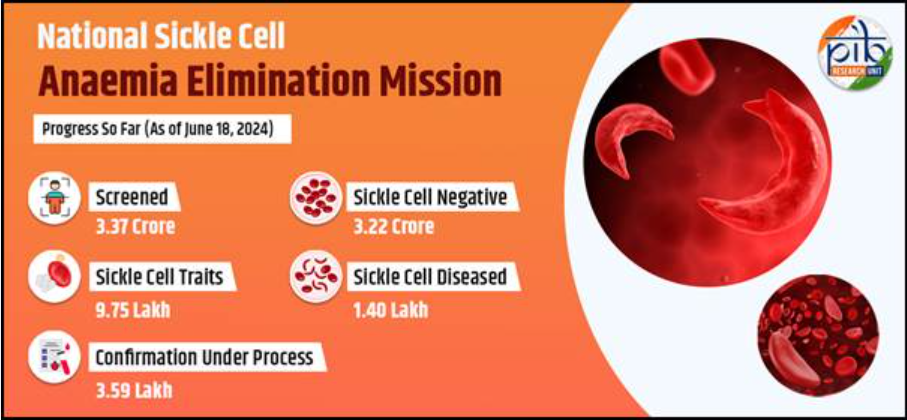
- Launched: July 1, 2023.
- Objective: To eradicate Sickle Cell Disease (SCD) through awareness campaigns and screening programs.
- Focus Areas: Special emphasis on tribal populations in Central, Western, and Southern India.
- Significance: Ensures early detection and treatment, improving health outcomes for affected tribal communities.
12. Mission Indradhanush
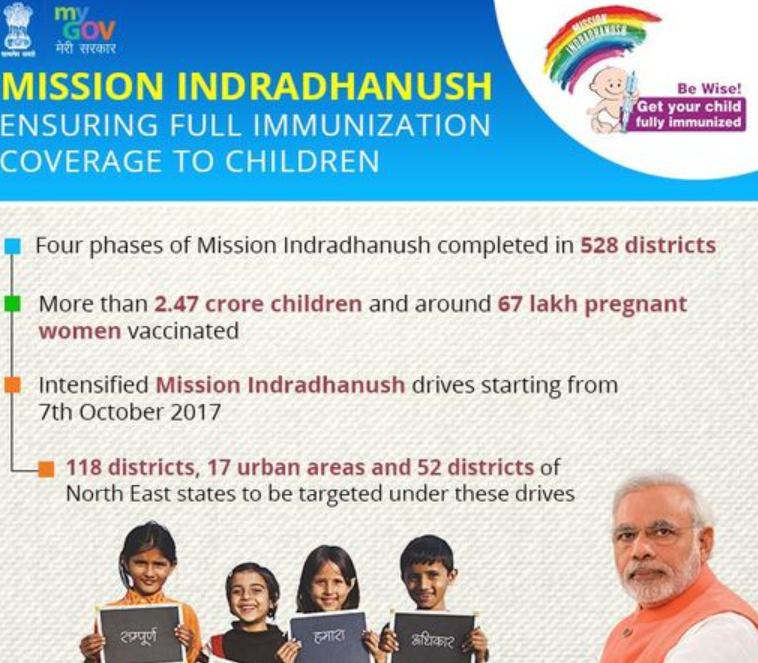
- Objective: Ensures full immunisation for children and pregnant women, with a special focus on tribal communities.
- Key Features: Expands vaccination coverage, including free COVID-19 vaccines.
- Significance: Improves health outcomes by reducing preventable diseases in tribal populations.
13. Support to Tribal Research Institutes (TRIs)
- Objective: To preserve and promote tribal culture through research and documentation.
- Focus Areas: Research on tribal languages, traditions, medicinal practices, and organising cultural events.
- Significance: Strengthens the cultural heritage of tribal communities and facilitates socio-economic research.
14. Particularly Vulnerable Tribal Groups (PVTGs) Development Program
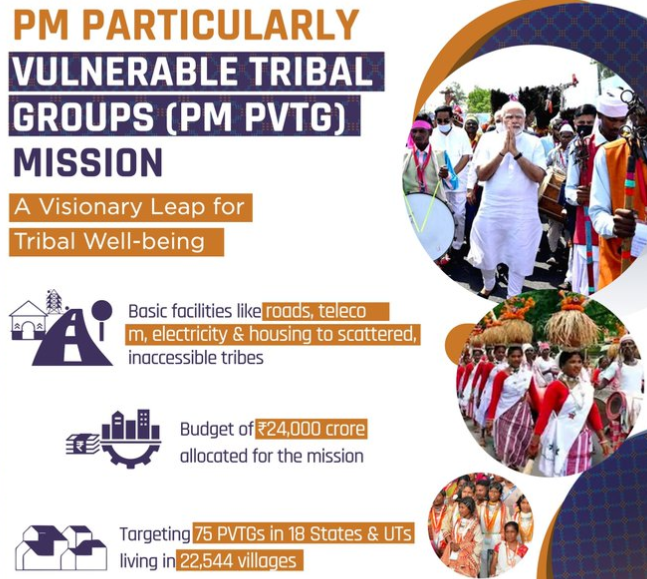
- Objective: To support the socio-economic development of the most vulnerable tribal communities.
- Implementation: The scheme focuses on addressing gaps and providing tailored support to 75 identified PVTGs.
- Impact: Improves living standards and provides specialised support for the upliftment of these communities.
- Significance: Ensures that the most marginalised tribal groups are not left behind in India’s development journey.
| Practice Question: Examine the significance of government schemes for the socio-economic empowerment of India’s tribal communities. Discuss their impact on bridging developmental gaps and ensuring inclusive growth.(250 Words /15 marks) |

